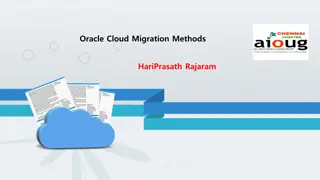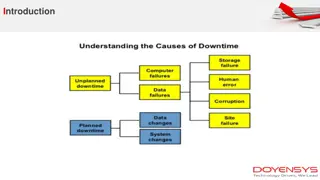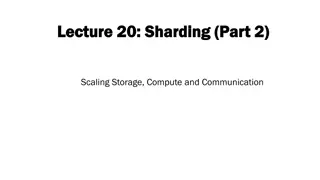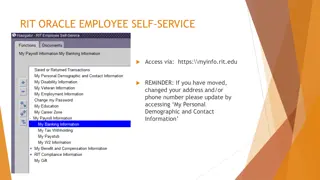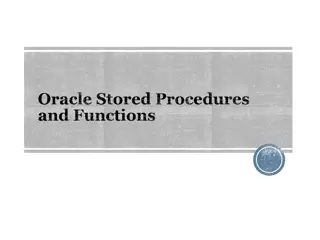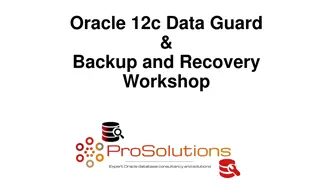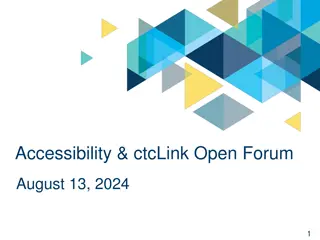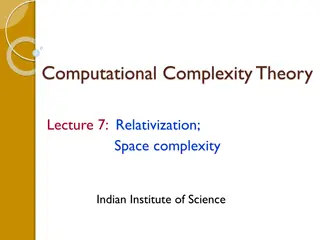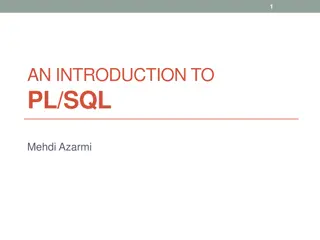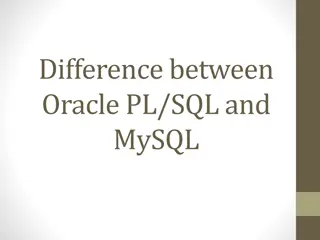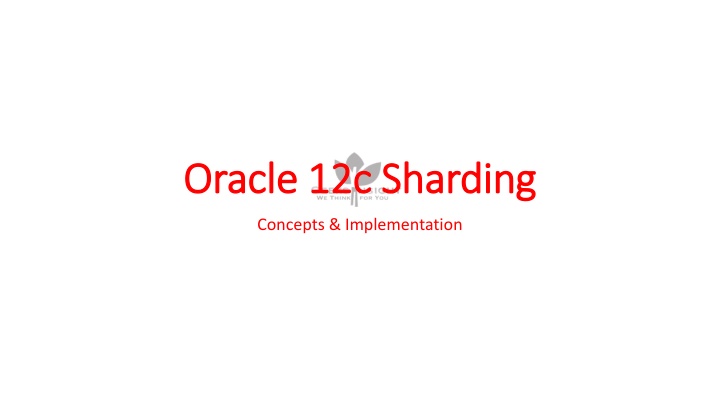
Oracle Sharding - Concepts and Implementation Explained
Learn about Oracle Sharding, a database partitioning technique that distributes large databases into smaller, more manageable parts called data shards. Understand the benefits, comparison with other databases, and considerations for implementation.
Download Presentation

Please find below an Image/Link to download the presentation.
The content on the website is provided AS IS for your information and personal use only. It may not be sold, licensed, or shared on other websites without obtaining consent from the author. If you encounter any issues during the download, it is possible that the publisher has removed the file from their server.
You are allowed to download the files provided on this website for personal or commercial use, subject to the condition that they are used lawfully. All files are the property of their respective owners.
The content on the website is provided AS IS for your information and personal use only. It may not be sold, licensed, or shared on other websites without obtaining consent from the author.
E N D
Presentation Transcript
Oracle 12c Oracle 12c Sharding Sharding Concepts & Implementation
What is What is Sharding Sharding? ? Sharding is a type of database partitioning that separates very large databases the into smaller, faster, more easily managed parts called data shards. The word shard means a small part of a whole. A mechanism of horizontal scaling Distributes datasets (tables/data) over multiple servers/databases Each shard is independent of databases All shards consists a single logical database
Before Oracle Sharding NoSQL Databases Cassandra MongoDB CouchDB Etc . MySQL NDB Cluster MS-SQL Sharding DB2 Partitioning/Sharding
Comparision NOSQL Oracle/MongoDB/Cassandra Source Oracle White Paper http://www.oracle.com/technetwork/database/availability/oraclesharding-whitepaper-3675509.pdf
RAC vs Sharding Source Oracle White Paper http://www.oracle.com/technetwork/database/availability/oraclesharding-whitepaper-3675509.pdf
Why Oracle Sharding? Oracle Sharding features is rich combination of Connection Pools, ONS, Sharding software (GSM), Partitioning, and Powerful Oracle Database. It is fully ACID complaint.. The following are the supportable features in Oracle Sharding Relational schemas. Sharding is no more NOSQL propreitory Database partitioning, uses rich Oracle partitioning features ACID properties and read consistency (very rich feature when compare to other databases) SQL and other programmatic interfaces, No Hassles of NOSQL type of language Complex data types Online schema changes Multi-core scalability Advanced security Compression & Replication Support High Availability features, (RAC & Dataguard) Enterprise-scale backup and recovery
Considerations Licensing for Sharding and Partitioning (See next slide) Application suitability, in general OLTP applications suits best with regional data distributed to single node and access through that node. Design of relational schema/table, especially the data distribution key as like other distributed databases. Its not a RAC (shared disk) architecture, its distributed database (shard/partitioning shared nothing) Existing Databases must have redesign to partitions and ensure application suitability as well.
Oracle Oracle Sharding Sharding Licensing Licensing On Premises/ BYOL Model <= 3 Primary Shards Included with in Enterprise License (includes Dataguard) If you plan to deploy RAC, Goldengate, Dataguard along with shards you need separate licensing for this options > 3 Primary Shards The licensing of Oracle Sharding requires that all shards be licensed for Oracle Enterprise Edition (EE) and one of the Oracle High Availability options (i.e. Active Data Guard or Oracle GoldenGate or Oracle RAC). ULA If organisations has Unlimited License Agreement with EE, RAC, Goldengate / Dataguard, then Sharding is at no cost. Source Oracle White Paper http://www.oracle.com/technetwork/database/availability/oraclesharding-whitepaper-3675509.pdf
Components of Oracle Sharding Sharded database (SDB) a single logical Oracle Database that is horizontally partitioned across a pool of physical Oracle Databases (shards) that share no hardware or software, the schema of this database is partitioned in other database (different hosts) Shards - independent physical Oracle databases that host a subset of the sharded databas SDB (schema) Global service (GDS) - database services that provide access to data in an SDB , implementation of general service to a distributed service. Shard catalog an Oracle Database that supports automated shard deployment, centralized management of a sharded database, and multi-shard queries, as like leader node, config instance in mongodb. Shard directors network listeners that enable high performance connection routing based on a sharding key, its like mongos instance for instance and holds the key information which stored in shard catalog. Connection pools - at runtime, act as shard directors by routing database requests across pooled connections Management interfaces - GDSCTL (command-line utility) and Oracle Enterprise Manager (GUI) to manage shards
Oracle Sharding Architecture (12c R2) shard1 shard1 db1 db1 Customer_orders Partition1 Customer_orders Partition1 Dataguard Broder 1521 SDB Primary Standby Global Service Shard Director 1521 Shared catalog Search Distributed Metadata The requested data is distributed to shard1 db1 Connection Pool Select custid,customernumner,product, qty from customer_orders where cust_id=11030; shard2 shard2 db2 db2 Customer_orders Partition2 Customer_orders Partition2 Takes the hash key of this customer id Dataguard Broder 1521 Primary Standby High Availability
How is the Data Distributed? Data is distributed across shards using Distribution Key When a table is created with type sharded table one of the column need to specified as distribution key , this is common in any distributed databases The distribution key can be of type consistent,hash,list. The distribution metadata is stored in shard catalog called gsmcatalog The table now created in multiple shards aka databases as partitions tables evenly distributed called chunks to each shard.
Sharded Database General Points Sharded Table A sharded table is a table that is partitioned into smaller and more manageable pieces among multiple databases, called shards. Sharded Table Family A sharded table family is a set of tables that are sharded in the same way. Ex: Master/detail table in one family Duplicated Tables In addition to sharded tables, an SDB can contain tables that are duplicated on all shards. Non-Table Objects Created on All Shards In addition to duplicated tables, other schema objects, such as users, roles, views, indexes, synonyms, functions, procedures, and packages, and non-schema database objects, such as tablespaces, tablespace sets, directories, and contexts, can be created on all shards. DDL Execution in a Sharded Database To create a schema in an SDB, you must issue DDL commands on the shard catalog database, which validates the DDLs and executes them locally first. DDL Syntax Extensions for the Sharded Database Oracle Sharding introduces changes to the SQL DDL statements. DDL statements with this syntax can only be executed against a sharded database.
Sharding Storage Attributes Partitions Distribution of partitions across shards is achieved by creating partitions in tablespaces that reside on different shards. Tablespaces Each partition of a sharded table is stored in a separate tablespace, making the tablespace the unit of data distribution in an SDB. Tablespace Sets Tablespace Set is created to group the tablespaces between different shards Chunks Each chunk contains corresponding partitions from the tables or table family
Sharding - Methods CREATE SHARDED TABLE customers ( cust_id NUMBER NOT NULL , name VARCHAR2(50) , address VARCHAR2(250) , location_id VARCHAR2(20) , class VARCHAR2(3) , signup DATE , CONSTRAINT cust_pk PRIMARY KEY(cust_id) ) PARTITION BY CONSISTENT HASH (cust_id) PARTITIONS AUTO TABLESPACE SET ts1 ; System Managed Sharding System-managed sharding is a sharding method which does not require the user to specify mapping of data to shards. Data is automatically distributed across shards using partitioning by consistent hash. The partitioning algorithm evenly and randomly distributes data across shards. Consistent Hash, Linear Hash Composite Sharding The composite sharding method allows you to create multiple shardspaces for different subsets of data in a table partitioned by consistent hash. A shardspace is set of shards that store data that corresponds to a range or list of key values. CREATE SHARDED TABLE customers ( cust_id NUMBER NOT NULL , name VARCHAR2(50) , address VARCHAR2(250) , location_id VARCHAR2(20) , class VARCHAR2(3) , CONSTRAINT cust_pk PRIMARY KEY(class, cust_id) ) PARTITIONSET BY LIST (class) PARTITION BY CONSISTENT HASH (cust_id) PARTITIONS AUTO (PARTITIONSET gold VALUES ( gld ) TABLESPACE SET tbs1, PARTITIONSET silver VALUES ( slv ) TABLESPACE SET tbs2) ; CREATE SHARDED TABLE customers ( cust_id NUMBER NOT NULL , name VARCHAR2(50) , address VARCHAR2(250) , location_id VARCHAR2(20) , class VARCHAR2(3) , signup_date DATE , CONSTRAINT cust_pk PRIMARY KEY(cust_id, signup_date) ) Using Subpartitions with Sharding Because Oracle Sharding is based on table partitioning, all of the subpartitioning methods provided by Oracle Database are also supported for sharding. TABLESPACE SET ts1 PARTITION BY CONSISTENT HASH (cust_id) SUBPARTITION BY RANGE (signup_date) SUBPARTITION TEMPLATE ( SUBPARTITION per1 VALUES LESS THAN (TO_DATE('01/01/2000','DD/MM/YYYY')), SUBPARTITION per2 VALUES LESS THAN (TO_DATE('01/01/2010','DD/MM/YYYY')), SUBPARTITION per3 VALUES LESS THAN (TO_DATE('01/01/2020','DD/MM/YYYY')), SUBPARTITION future VALUES LESS THAN (MAXVALUE)) ) PARTITIONS AUTO ;
Changes to Syntax Changes to Syntax Create Tablespace/Tables Oracle Sharding introduces changes to the SQL DDL statements. DDL statements with this syntax can only be executed against a sharded database. CREATE TABLESPACE SET tablespace_set [IN SHARDSPACE shardspace] [USING TEMPLATE ( { MINIMUM EXTENT size_clause | BLOCKSIZE integer [ K ] CREATE [ { GLOBAL TEMPORARY | SHARDED | DUPLICATED} ] TABLE [ schema. ] table { relational_table | object_table | XMLType_table } [ PARENT [ schema. ] table ] . Tablespace set TS1 Tablespace set TS1 table_partitioning_clauses table_partitioning_clauses ::= { hash_partitions | list_partitions | composite_range_partitions | composite_hash_partitions | composite_list_partitions | reference_partitioning | system_partitioning | consistent_hash_partitions | consistent_hash_with_subpartitions | partition_set_clause } ; ::= {range_partitions range_partitions | |
Limitations of Sharded Tables Limitations for sharded tables in the current release: There is no default tablespace set for sharded tables. A temporary table cannot be sharded or duplicated. Index-organized sharded tables are not supported. A sharded table cannot contain a nested table column or an identity column. A primary key constraint defined on a sharded table must contain the sharding column(s). A foreign key constraint on a column of a sharded table referencing a duplicated table column is not supported. System partitioning and interval range partitioning are not supported for sharded tables. Specification of individual hash partitions is not supported for partitioning by consistent hash. A column in a sharded table used in PARTITION BY or PARTITIONSET BY clauses cannot be a virtual column. The following options are not supported for a sharded table: rename add foreign key constraint all operations on individual partitions The following are not supported for duplicated tables: rename table rename column/column type add/modify column add/modify constraint drop column modify/rename column type truncate table truncate partition drop partition/subpartition enabling nologging, parallel and inmemory options
Connecting to a Sharded Database SHARDING REQUEST ROUTING Session-Based Request Routing Connect string must contain: (SHARD_KEY=...) JDBC: connection.setShardKey(<shard_key>,<shard_group_key>); Support for OCI/OCCI (C++)/ODP.NET Support for PHP, Python, Perl, and Node.js In addition to Session-Based routing, Statement-Level Request Routing Cross-Shard Queries using GSM service connected to SDB catalog database
Oracle Sharding How to Implement? Like RAC ? #(#*$(# No It s simple
Configuring Oracle Sharding Environment Planning Node Type IP Address Home Ports DB Name Scheduler Agent Shard Catalog Node 192.168.56.150 Host: shardcat Oracle Home: /u01/app/oracle/12.2.0.1/db_1 GSM home: /u01/app/oracle/12.2.0.1/GSM GSM Listener 1539 DB Listener 1521 SCAT Shard1 192.168.56.151 Host: shard1 Oracle Home: /u01/app/oracle/12.2.0.1/db_1 DB Listener 1521 sh1 Scheduler Agent - Shard2 192.168.56.152 Host: shard2 Oracle Home: /u01/app/oracle/12.2.0.1/db_1 DB Listener 1521 sh2 Scheduler Agent -
Steps to Configure Oracle Sharding Step Nodes/Hosts Step Details 1 shardcat/Shard1/Shard2 Install Oracle Software Only 12cR2 Preferably Same Location 2 shardcat Create Database SCAT using DBCA (NON CDB) 3 shardcat Install GSM Software as Separate Home 4 shardcat Create Environment Setup 5 Shardcat Prepare SCAT database for Sharding - Prerequisities 6 shardcat Configure Shard Catalog using GSDCTL Create Shard Catalog in SCAT 7 shard1/shard2 Start the SCH Agent & Register Shard nodes to SCAT database 8 shardcat Create Shard Group/Director/Add Shards 9 shardcat Deploy Shards using GSDCTL This will eventually create databases in shard1/shard2 10 shardcat Verify Shard Configuration 11 shardcat Create Global Service using GSDCTL 12 shardcat Create sample schema and Tablespace set and see that propagate to shard1/shard2 13 shardcat Connect to sample schema and create shard table 14 Shardcat/shard1/shard2 Verify the sample table is created across shards
Step 1 : Install Oracle 12c R2 Software Install Oracle 12cR2 Software on all three nodes shardcat/shard1/shard2 Complete Pre-requisities Install with Software only option Sample options to change in <softwarelocation>/response/db_install.rsp oracle.install.option=INSTALL_DB_SWONLY ORACLE_HOSTNAME=Geek DBA11g UNIX_GROUP_NAME=oinstall INVENTORY_LOCATION=/u02/app/oraInventory ORACLE_HOME=/u01/app/oracle/product/12.1.0/db_1 ORACLE_BASE=/u01/app/oracle oracle.install.db.InstallEdition=EE oracle.install.db.DBA_GROUP=dba oracle.install.db.OPER_GROUP=oper oracle.install.db.BACKUPDBA_GROUP=dba oracle.install.db.DGDBA_GROUP=asmadmin oracle.install.db.KMDBA_GROUP=dba SECURITY_UPDATES_VIA_MYORACLESUPPORT=false DECLINE_SECURITY_UPDATES=true Create Oracle Home Directories mkdir -p /u01/app/oracle/product/12.1.0/db_1 mkdir -p /u02/app/oraInventory chown -R oracle:oinstall /u02/app/oraInventory Sample Run Installer Command ./runInstaller -silent -ignoresysprereqs -responsefile /home/oracle/database/response/db_install.rsp
Step 2: Create ShardCatalog Database On shardcat Node:- Create Directories mkdir p /u01/app/oracle/flash_recover_area/SCAT mkdir p /u01/app/oracle/fast_recovery_area/SCAT mkdir p /u01/oradata/SCAT mkdir p /u01/app/oracle/admin/SCAT/adump Run DBCA ./dbca -silent \ -DatafileDestination /u01/app/oracle/SCAT -storageType FS \ -listeners LISTENER12 \ -registerWithDirService false \ -characterSet AL32UTF8 \ -nationalCharacterSet AL16UTF16 \ -databaseType MULTIPURPOSE \ -memoryPercentage 40 \ -memoryType AUTO -createDatabase \ -templateName General_Purpose.dbc \ -gdbName SCAT \ -sid SCAT \ -SysPassword ****\ -createAsContainerDatabase false\ -SystemPassword ***\ -emConfiguration NONE\ -redoLogFileSize 100 \ -recoveryAreaDestination /u01/app/oracle/SCAT \
Step 3: Install GSM Software in Shardcat In Shardcat Node:- Download from Oracle Downloads page or Edelivery.oracle.com Unzip the GSM Software Install as separate Home
Step 5 : Prepare SCAT database for Sharding - Prerequisites In Shardcat : SCAT Database alter system set db_create_file_dest='/u01/ora12c/app/oracle/oradata' scope=both; alter system set open_links=16 scope=spfile; alter system set open_links_per_instance=16 scope=spfile; startup force alter user gsmcatuser account unlock; alter user gsmcatuser identified by oracle; CREATE USER mygdsadmin IDENTIFIED BY oracle; GRANT connect, create session, gsmadmin_role to mygdsadmin; grant inherit privileges on user SYS to GSMADMIN_INTERNAL; execute dbms_xdb.sethttpport(8080); commit; @?/rdbms/admin/prvtrsch.plb exec DBMS_SCHEDULER.SET_AGENT_REGISTRATION_PASS('oracleagent');
Step 6: Create Shard Catalog in SCAT In Shardcat node, in SCAT Database & Set environment to GSM Home # gdsctl GDSCTL> create shardcatalog -database shardcat:1521:SCAT -chunks 12 -user mygdsadmin/oracle -sdb SCAT -region region1 GDSCTL>add gsm -gsm sharddirector1 -listener 1571 -pwd oracle -catalog shardcat:1521:SCAT -region region1 GDSCTL>start gsm -gsm sharddirector1 GDSCTL>add credential -credential oracle_cred -osaccount oracle -ospassword **** GDSCTL> exit
Step 7: Start the Scheduler Agent on Shard Nodes In Shard1 & 2 : Scheduler Agent is already installed if you install oracle database software just start it #Set Oracle Home #schagent start #schagent status # echo oracleagent | schagent registerdatabase shardcat 8080 provide name of host not database
Step 8 : Create Shard Group/Director/Add Shards GDSCTL>set gsm -gsm sharddirector1 GDSCTL>connect mygdsadmin/oracle Catalog connection is established GDSCTL>-- add shard group GDSCTL>add shardgroup -shardgroup primary_shardgroup -deploy_as primary -region region1 The operation completed successfully GDSCTL>-- add shard1 GDSCTL>add invitednode shard1 GDSCTL>create shard -shardgroup primary_shardgroup -destination shard1 -credential oracle_cred DB Unique Name: sh1 GDSCTL> --add shard2 GDSCTL>add invitednode shard2 GDSCTL>create shard -shardgroup primary_shardgroup -destination shard2 -credential oracle_cred DB Unique Name: sh2
Step 9 : Deploy Shards In shardcat node, using gsdctl, run gsdctl> deploy Note: This will create the databases in shard1 and shard2 using dbca and create listeners automatically
Step 11 : Create Global Service using GSDCTL Using GDSCTL on shardcat gdsctl> add service service test_srv role primar gdsctl> config service gdsctl> start service gdsctl> status service
Step 12: Create sample schema and Tablespace set and see that propagate to shard1/shard2 #[oracle12c@sdb1 ~]$ db_env Sqlplus / as sysdba alter session enable shard ddl; create user app_schema identified by oracle; grant all privileges to app_schema; grant gsmadmin_role to app_schema; grant select_catalog_role to app_schema; grant connect, resource to app_schema; grant dba to app_schema; grant execute on dbms_crypto to app_schema; #Create Sharded Tablespace & Test out conn app_schema/oracle alter session enable shard ddl; SQL> CREATE TABLESPACE SET TSP_SET_1 using template (datafile size 100m extent management local segment space management auto ); SQL> CREATE TABLESPACE products_tsp datafile size 100m extent management local uniform size 1m; Note: For any command that need to be shard, you must enable shard ddl at session level before running the sql command
Step 14: Verify Distribution of Tables to shards On Shard Catalog SDB Database
Step 14: Verify Distribution of Tables to Shards On Shard1, SH1 database the customer table is partitioned and some of the partitions created here On Shard2, SH2 database the customer table is partitioned and some of the partitions created here
Maintaining Shards Next Part Adding Shard Recovering Shard Deleting Shard Resharding Validating Shard
Thanks for Joining. Questions ??? References https://docs.oracle.com/database/122/ADMIN/sharding-overview.htm#ADMIN-GUID-0F39B1FB-DCF9-4C8A-A2EA-88705B90C5BF









